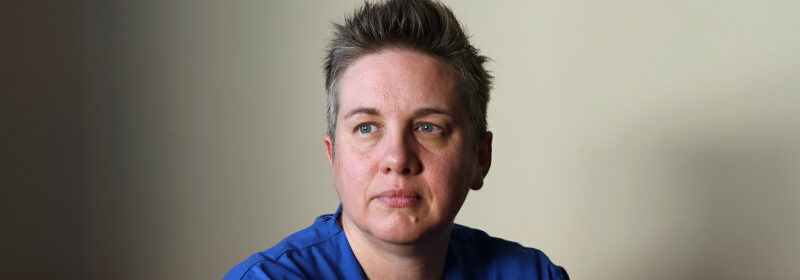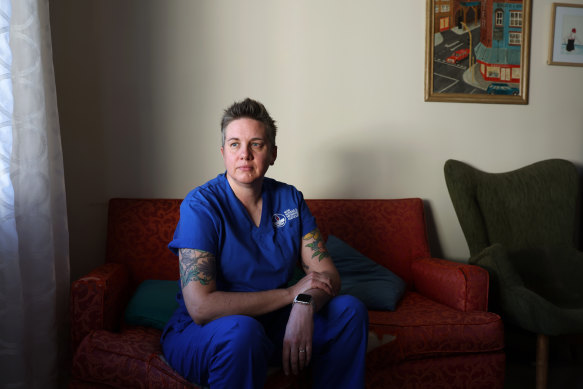“Running between rooms”: Midwife shortage causing trauma and burnout

Save articles for later
Add articles to your saved list and come back to them any time.
The number of working midwives is declining, with advocates blaming workload pressures and exposure to birth trauma.
Data from the Department of Health and Aged Care shows the number of midwives employed in NSW has decreased year-on-year, with 555 fewer midwives in 2022 than in 2016.
Nationally, the workforce has decreased by 1220 since 2016 with 25,557 practitioners working in midwifery in 2022.
Midwives aged 50 to 59 were the fastest-shrinking cohort.
Western Sydney University Professor of Midwifery Hannah Dahlen attributed the decline to COVID-19 pressures coupled with midwives losing faith in the model of care.
“You’ve got midwives running between rooms, not giving women adequate care and feeling at the end of the day that they’re failing women,” she said.
“Many midwives are quite burnt out and quite frustrated with the highly medicalised system that they work in … and are getting traumatised by what they’re witnessing. On and on go the ripples regarding postnatal care.”
A study this year found 15 in every 100 NSW nurses and midwives report having high levels of symptoms that would meet the criteria of post-traumatic stress disorder.
Midwife and lactation consultant Emma Gedge says the midwife shortage means maternity wards aren’t being properly staffed.
NSW Nurses and Midwives Association counsellor and registered midwife Emma Gedge said limited staff and maternity beds meant non-specialist nurses were working in maternity wards.
“When I started my midwifery career, it was very unusual to have a registered nurse working on the postnatal ward and now it’s every single shift,” she said.
“Women can come into maternity services and stay in the postnatal area and never actually see a midwife.”
In 2022, there were 6646 practitioners working in midwifery in NSW.
Gedge, who is a lactation consultant, warned the shortage was affecting quality of care and breastfeeding outcomes.
The number of babies fully breastfed after they and their mothers are released from the hospital has declined for five years in a row in NSW, dropping from 78.5 per cent in 2017 to 73.1 per cent in 2021.
“The staff are fabulous nurses but they probably haven’t done any kind of in-depth training on breastfeeding, [whereas] midwives are the experts in breastfeeding,” she said.
Births in the state increased for the first time in five years in 2021 with 99,316 births while births are becoming more complicated.
The rate of normal vaginal birth fell from 54.5 per cent in 2017 to 50.7 per cent in 2021, according to the latest NSW Mothers and Babies report, which may be affected by higher gestational age and maternal health.
“Coupled with the increasing rate of intervention in our system, you just can’t possibly get around to everyone,” Gedge said.
NSW Nurses and Midwives Union Assistant General Secretary Michael Whaites said members had reported hospitals were short anywhere between 20 and 50 per cent on the number of midwives needed.
Whaites said there was a “steady reduction” in the number of senior midwives willing to work full-time, which also puts pressure on less experienced midwives.
”They don’t have that skill and knowledge support around them. And that leads to them either leaving the industry or reducing their hours also,” he said.
“We’ve seen an absolute knock-on effect.”
NSW Health Minister Ryan Park’s spokeswoman referred questions about specific midwife numbers to NSW Health but confirmed the government has committed to a 3:1 ratio in maternity wards.
NSW Health also provides scholarships for rural postgraduate midwifery students and is implementing a mentoring program specifically for midwives.
A NSW Health spokesperson acknowledged there are “challenges” in the midwifery workforce both in Australia and across the globe.
“The reasons for caesarean section, and other interventions, are complex and multi-factorial. The decision is based on individual circumstances, personal choice, and most importantly, guided by the specific clinical needs of the birthing woman and her baby,” the spokesperson said.
A recent study found one in 10 women in Australia said they were made to feel abused, powerless or dehumanised by a healthcare provider before, during or after childbirth, treatment that amounts to “obstetric violence”.
Last month an upper house select committee into preventing birth trauma in NSW was established, chaired by Animal Justice MLC Emma Hurst.
She said she was expecting a large number of submissions and that midwifery continuity of care for new mothers was likely to be a key focus.
“If the solution is continuity of care, how do we ensure that we have the retention of midwives?” she asked.
“There is unlikely to be a silver bullet.”
Park said he supported the birth trauma inquiry.
“It’s important we know more about the causes and factors contributing to birth trauma and its impact on women and their families,” he said.
The Morning Edition newsletter is our guide to the day’s most important and interesting stories, analysis and insights. Sign up here.
Most Viewed in National
From our partners
Source: Read Full Article
